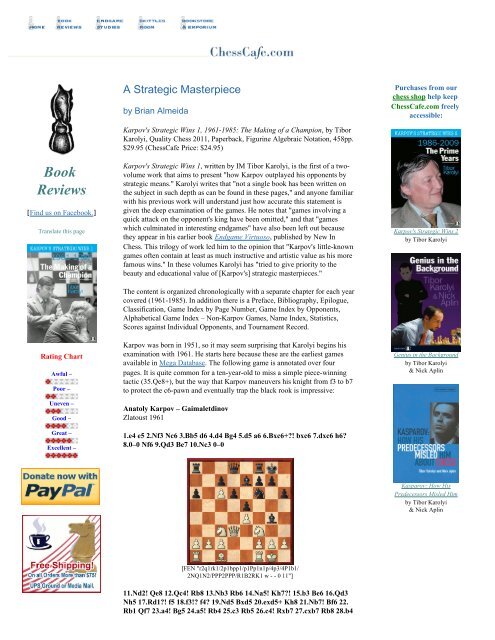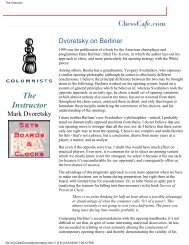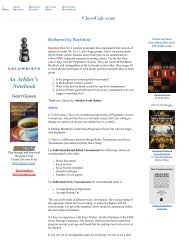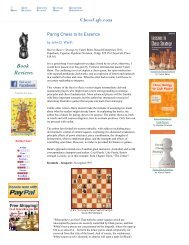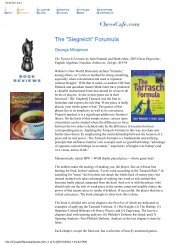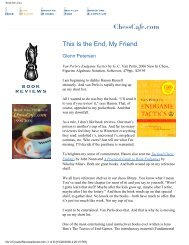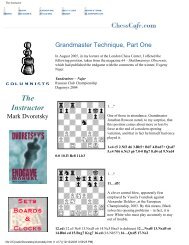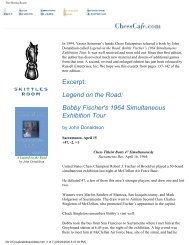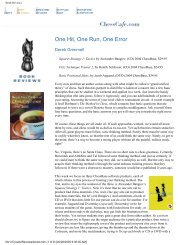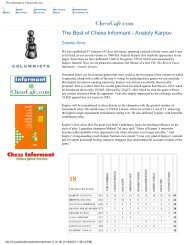You also want an ePaper? Increase the reach of your titles
YUMPU automatically turns print PDFs into web optimized ePapers that Google loves.
Book<br />
Reviews<br />
[Find us on Facebook.]<br />
Translate this page<br />
Rating Chart<br />
Awful –<br />
Poor –<br />
Uneven –<br />
Good –<br />
Great –<br />
Excellent –<br />
A <strong>Strategic</strong> Masterpiece<br />
by Brian Almeida<br />
<strong>Karpov's</strong> <strong>Strategic</strong> <strong>Wins</strong> 1, 1961-1985: The Making of a Champion, by Tibor<br />
Karolyi, Quality <strong>Chess</strong> 2011, Paperback, Figurine Algebraic Notation, 458pp.<br />
$29.95 (<strong>Chess</strong><strong>Cafe</strong> Price: $24.95)<br />
<strong>Karpov's</strong> <strong>Strategic</strong> <strong>Wins</strong> 1, written by IM Tibor Karolyi, is the first of a twovolume<br />
work that aims to present "how Karpov outplayed his opponents by<br />
strategic means." Karolyi writes that "not a single book has been written on<br />
the subject in such depth as can be found in these pages," and anyone familiar<br />
with his previous work will understand just how accurate this statement is<br />
given the deep examination of the games. He notes that "games involving a<br />
quick attack on the opponent's king have been omitted," and that "games<br />
which culminated in interesting endgames" have also been left out because<br />
they appear in his earlier book Endgame Virtuoso, published by New In<br />
<strong>Chess</strong>. This trilogy of work led him to the opinion that "<strong>Karpov's</strong> little-known<br />
games often contain at least as much instructive and artistic value as his more<br />
famous wins." In these volumes Karolyi has "tried to give priority to the<br />
beauty and educational value of [<strong>Karpov's</strong>] strategic masterpieces."<br />
The content is organized chronologically with a separate chapter for each year<br />
covered (1961-1985). In addition there is a Preface, Bibliography, Epilogue,<br />
Classification, Game Index by Page Number, Game Index by Opponents,<br />
Alphabetical Game Index – Non-Karpov Games, Name Index, Statistics,<br />
Scores against Individual Opponents, and Tournament Record.<br />
Karpov was born in 1951, so it may seem surprising that Karolyi begins his<br />
examination with 1961. He starts here because these are the earliest games<br />
available in Mega Database. The following game is annotated over four<br />
pages. It is quite common for a ten-year-old to miss a simple piece-winning<br />
tactic (35.Qe8+), but the way that Karpov maneuvers his knight from f3 to b7<br />
to protect the c6-pawn and eventually trap the black rook is impressive:<br />
Anatoly Karpov – Gaimaletdinov<br />
Zlatoust 1961<br />
1.e4 e5 2.Nf3 Nc6 3.Bb5 d6 4.d4 Bg4 5.d5 a6 6.Bxc6+?! bxc6 7.dxc6 h6?<br />
8.0–0 Nf6 9.Qd3 Be7 10.Nc3 0–0<br />
[FEN "r2q1rk1/2p1bpp1/p1Pp1n1p/4p3/4P1b1/<br />
2NQ1N2/PPP2PPP/R1B2RK1 w - - 0 11"]<br />
11.Nd2! Qe8 12.Qc4! Rb8 13.Nb3 Rb6 14.Na5! Kh7?! 15.b3 Be6 16.Qd3<br />
Nh5 17.Rd1?! f5 18.f3!? f4? 19.Nd5 Bxd5 20.exd5+ Kh8 21.Nb7! Bf6 22.<br />
Rb1 Qf7 23.a4! Bg5 24.a5! Rb4 25.c3 Rb5 26.c4! Rxb7 27.cxb7 Rb8 28.b4<br />
Purchases from our<br />
chess shop help keep<br />
<strong>Chess</strong><strong>Cafe</strong>.com freely<br />
accessible:<br />
<strong>Karpov's</strong> <strong>Strategic</strong> <strong>Wins</strong> 2<br />
by Tibor Karolyi<br />
Genius in the Background<br />
by Tibor Karolyi<br />
& Nick Aplin<br />
Kasparov: How His<br />
Predecessors Misled Him<br />
by Tibor Karolyi<br />
& Nick Aplin
Rxb7 29.b5 axb5 30.cxb5 Qe8 31.Qc4 Qa8 32.Qc6 Qa7+ 33.b6 cxb6 34.<br />
axb6 Qa6 35.Bd2? Nf6 36.Qxd6 e4 37.Bxf4?! Bxf4 38.Qxf4 exf3 39.Qxf3<br />
Rxb6 40.Rxb6 Qxb6+ 41.Kh1 Qd6 42.h3 Kh7 43.Qe2 Ng8 44.Qe6 Qxe6 45.<br />
dxe6 Nf6 46.e7? Kg8 47.Re1 Kf7 48.Kh2 Ke8 49.Re5 Ng8 50.Kg3 Nxe7 51.<br />
Kg4 Kf7 52.h4 Ng8 53.Kf4 Kf6 54.g4 Ne7 55.h5 g5+ 56.Ke4 Kf7 57.Ra5<br />
Ng8 58.Ke5 Kg7 59.Ra7+ Kh8 60.Ke6 1–0<br />
Each chapter ends with a summary of results. Here Karolyi notes, "The<br />
database contains eighteen games from this year, of which Karpov won<br />
twelve, drew five and lost only one. It is likely that his overall results were<br />
lower and Karpov publicized only his best games from the early period of his<br />
life. Even so, his play was undoubtedly at a high level for a ten year old."<br />
Later chapters also include a pie chart and statistics of results, and it can be<br />
interesting to browse these pages independently. For instance, <strong>Karpov's</strong> most<br />
successful year was 1977, where he scored an amazing 77% (+36 =25 –2).<br />
Furthermore, in the "Scores against Individual Opponents" index we can see a<br />
90% score against Nunn (+4 =1 –0), whereas Kasparov, Seirawan, and Torre<br />
each had the best scoring percentage of fifty percent. Though these only<br />
include games played while Karpov was world champion.<br />
The Classification index lists strategic themes, such as "Attack on the a- or hfile,"<br />
"Bishop on the long diagonal," "Checkmating in the endgame," "Fixing<br />
a weakness," "King activation," "Material imbalance," "Playing on both<br />
flanks," etc.<br />
Here is an example of positional sacrifice with Karpov, as black, to move:<br />
Osterman, Rudolf – Karpov, Anatoly<br />
Portoroz/Ljubljana 1975<br />
[FEN "1r1q1rk1/p2nbp1p/4p1pB/2p1P2n/2Pp4/<br />
1P1B1P2/P2NQP1P/R4R1K b - - 0 18"]<br />
Karpov outrated his opponent by four hundred points, but his concept is still<br />
stunning: 18...Bg5!!<br />
"Exchange sacrifices are often not difficult to understand; the problem is that<br />
they may not occur to us easily. This one is strong for several reasons. White's<br />
rooks have no useful files, the e5-pawn will soon perish and White's f-pawns<br />
are also weak. Finally, the f4-square will be a tremendous outpost for the<br />
black pieces, especially the knight."<br />
19.Bxf8 Qxf8 20.Rg1 Bf4 21.Ne4 Bxe5 22.Ng3 Nf4 23.Qd2 Bc7!<br />
"Black has plenty of time to build his position. With his last move he<br />
withdraws his bishop to a safe spot while preventing any future queen<br />
invasions on a5."<br />
24.Bf1 Qd6 25.Re1
[FEN "1r4k1/p1bn1p1p/3qp1p1/2p5/2Pp1n2/<br />
1P3PN1/P2Q1P1P/4RBRK b - - 0 25"]<br />
"Preventing the white pieces from using the e4-square."<br />
25...f5! 26.Be2 Kf7 27.Rb1 a5<br />
"Karpov makes sure that White will not be able to open a file on the<br />
queenside."<br />
28.a3 h5!<br />
"Preparing to push White back even further."<br />
29.Rge1?! h4 30.Nf1<br />
30...Qe7!<br />
[FEN "1r6/2bn1k2/3qp1p1/p1p2p2/2Pp1n1p/<br />
PP3P2/3QBP1P/1R2RN1K b - - 0 30"]<br />
"Karpov exploits White's error on the previous move. The rook has vacated<br />
the g-file, so he immediately looks to invade there." Karpov went on to win at<br />
move forty-six.<br />
Another impressive moment from <strong>Karpov's</strong> youth can be seen in the next<br />
game:<br />
Karpov, Anatoly – Piskunov, Dmitry<br />
Zlatoust, 1962<br />
[FEN "4r3/ppq1n1kp/2p1r1p1/2PpNp2/<br />
1P1P4/P4PP1/3QR2P/4R1K1 w - - 0 32"]
Piskunov had just played 31...Ne7? and Karpov with "remarkable alertness"<br />
answered 32.Nd3!. This is a move few would even consider; for an elevenyear-old<br />
it is all the more outstanding! The finish was 32...Rxe2 33.Qxe2 h5<br />
34.Qe6 h4 35.Qd6 1–0<br />
Following this game there is a brief interview with <strong>Karpov's</strong> trainer from this<br />
time period, Leonid Gravtol, along with commentary from other students<br />
Evgeny Sveshnikov and Alexander Panchenko. Gravtol also trained Gennady<br />
Timoscenko, Semen Dvoirys, and Tatania Shumiakina. The section finishes<br />
with one of Gravtol's games, where Karolyi encourages the reader to decide<br />
for themselves how much <strong>Karpov's</strong> style reflects that of his trainer. In all,<br />
there are fifty-three games featuring players other than Karpov and seventysix<br />
Karpov games.<br />
<strong>Karpov's</strong> <strong>Strategic</strong> <strong>Wins</strong> 1 is a masterpiece! The explanations are written with<br />
clarity and precision, the depth of the analysis is incredible, the production is<br />
outstanding, and the game examples are as enlightening as they are<br />
entertaining. This deserves book of the year accolades. Do yourself a favor<br />
and buy it in hardcover, it's worth it!<br />
My assessment of this book:<br />
Order <strong>Karpov's</strong> <strong>Strategic</strong> <strong>Wins</strong> 1<br />
by Tibor Karolyi<br />
Read an excerpt in our shop!<br />
Comment on this week's column via our Contact Page! Pertinent responses<br />
will be posted below daily.<br />
[<strong>Chess</strong><strong>Cafe</strong> Home Page] [Book Review] [Columnists]<br />
[Endgame Study] [The Skittles Room] [<strong>Chess</strong><strong>Cafe</strong> Archives]<br />
[<strong>Chess</strong><strong>Cafe</strong> Links] [Online Bookstore] [About <strong>Chess</strong><strong>Cafe</strong>.com]<br />
[Contact <strong>Chess</strong><strong>Cafe</strong>.com]<br />
© 2011 BrainGamz, Inc. All Rights Reserved.<br />
"<strong>Chess</strong><strong>Cafe</strong>.com®" is a registered trademark of BrainGamz, Inc.


